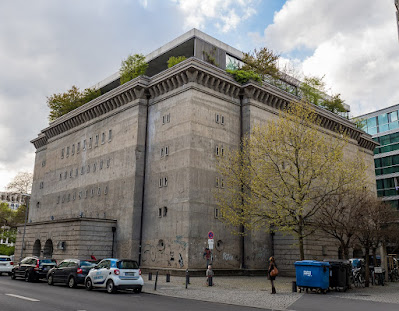 |
| Bunker on Reinhardtstrasse |
Despite several attempts to visit this space in the past couple of years, last week was my first time inside the Bunker Berlin. Housed in a former Nazi bomb shelter, subsequently converted into a prisoner of war camp by the Soviets and then a techno warehouse night club in the 1990s, the bunker is somehow illustrative of the ever-evolving transformation of Berlin. And no less telling of Berlin as the self-made city of the 2000s, the building was purchased by an advertising executive in 2003 and fashioned into one of the coolest art spaces in town. When Hitler had the bunker built, there wasn't time or money to dig underground, and so the building went upwards. Thick, heavy walls, no windows, one entrance, but the "bunker" would withstand a bomb. In keeping with the aspirations of all Nazi buildings, envisioned for the roof was a statue of the triumphant German soldier. Today, the owner of the building has his penthouse perched atop the bunker; it is somehow in keeping with our times that the capitalist marks his status as the hero of contemporary Germany by placing his abode atop the bunker. Those who have seen Tár (dir. Todd Field, 2022) will be familiar with the interior of the penthouse, itself mimicking the aesthetic of the one time air raid shelter.  |
| Bunker before renovations |
A visit to the Boros collection—the advertising executive's private art collection—is an event, a production showcasing contemporary art. We buy a ticket for the privilege to become acquainted with a wealthy person's private collection, not a public musuem. A guided tour is the only way to visit the collection. Somehow, I had the feeling that if visitors were allowed to visit the Boros collection on an individual basis and the building was not so shrouded in history, the art would not be such a big drawcard for the average tourist. But for a look inside the building, visitors are happy to pay the relatively high entrance fee. It is also worth mentioning that the guide who led my tour was very knowledgeable and made the often highly conceptual art accessible to all. The bunker itself has been sanitized in the renovations, retaining the surface of the old walls, but none of the grime and grease of its former uses. The comparison would be the Pinault Collection in the restored Bourse de Commerce in Paris. But whereas Pinault brings works from outside into the exhibitions and installations, he lends work, and has a living breathing collection, Boros is amassing a private collection sealed within the bunker. |
| Adrian Morris, Filtration Plant, 1974 |
The art ranges in quality. I will say that much of it seems to have been bought with the space in mind as most of the work is sympathetic to the walls. Though Boros has collected work by a number of well known artists, his acquisition policy is one of buying works in the year that they are made. This results in a lot of contemporary art by artists who are emerging or in the early stages of their careers. That in itself is an admirable policy, but it does mean that the work can be uneven. While some of the work is radical and boundary breaking, other pieces had little resonance.
 |
| Anna Uddenberg, Rona's Revenge, 2020 |
Among the best of the often highly conceptual works on display were Anna Uddenberg's sculptures of women who contort their bodies to get the perfect selfie of their perfect butts. Decked out in BDSM gear, the figures are both fabulous and frightening in their simultaneous subsumption and critique of female identity, usually sexually defined. I was also impressed by Berenice Olmedo's display of mechatronic orthoses (acquired from her onetime work place) on strings, like puppets, dancing, until they fail and fall to the ground. When the orthoses falls, we immediately reflect with empathy on the absent wearer's attempts to walk. While other of Olmedo's work might challenge ableist notions of performance, her works on display in Bunker Berlin are about the resilience and resolve of those who once wore the orthoses.
 |
| Berenice Olmedo, Julieta, 2021 |
Also in the collection were a handful of paintings by a little known British artist, Adrian Morris. Morris's paintings were intriguing on a number of levels, navigating questions of space and looking at space from different angles. Spaces and landscape are seen through windows that appear to be in motion the longer we look at the works. The views from planes and trains or through unidentifiable windows at ambiguous spaces spoke of the shifting meanings of space and our continual reorientation dependent on the time and lens for looking. Morris's work represents the exception to Boros's commitment to buying in the year of execution, and is a welcome addition to the walls of the Berlin Bunker with its current identity as home to a private art colleciton.












